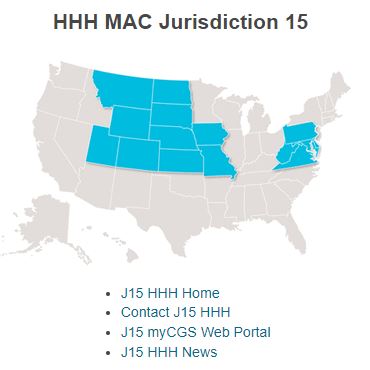
by editor | Sep 12, 2022 | Billing, Billing - General, Compliance and Regulatory - Directors, Financials, Metrics and KPIs, Office Setup, Rules and Regulations - Nurses
A Medicare Administrative Contractor (MAC) is a private health care insurer that has been awarded a geographic jurisdiction to process Medicare Part A and Part B medical claims for Fee For Service (FFS) beneficiaries.
CMS relies on these contractors to serve as the primary operational contact between the Medicare FFS program and the health providers enrolled in the program.
MACs are multi-state regional contractors who are responsible for administering Part A and Part B claims.
What types of MACs are there?
There are two types of MACs: Part A/B MACs and DME MACs.
Hospice claims are administered by Part A/B MACs. Part A/B MACs process about 95% of all FFS claims.
There are 12 Part A/B MACs.
Four of the MACs specialize in processing claims for hospice and home health providers
What geographic areas do each of the hospice and home health MACs cover?
The following map shows the geographic regions that each of the hospice MACs is responsible for administering.
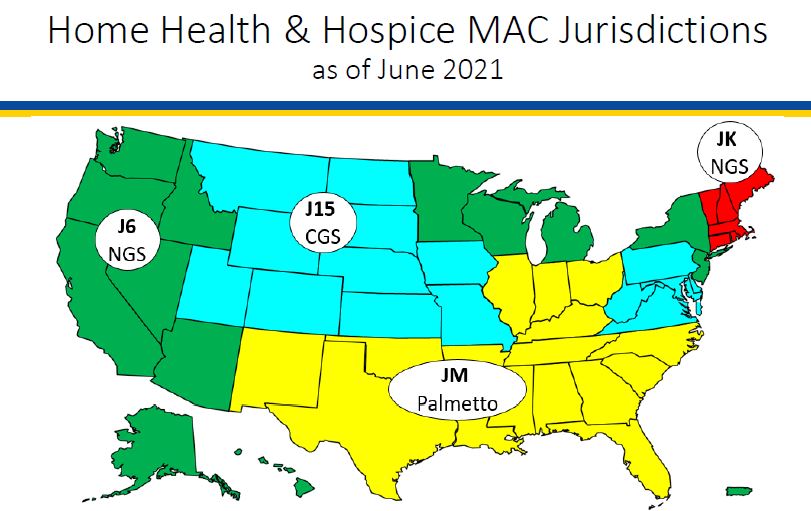
What activities do MACs perform?
MACS perform a number of activities including:
-
Provider Enrollment
-
Claims processing, payment, and payment notices
-
Provider customer service (but not beneficiary customer service)
-
Audit provider cost reports
-
Respond to provider inquiries
-
Audit payments and review medical records
How are MACs measured and how well do they perform?
Each year, CMS evaluates MAC performance against specific metrics in eleven functional areas. MAC performance quality has been consistently improving since CMS began measuring MAC performance. Average MAC performance has increased from 62% to 93% since CMS began measuring MAC performance.
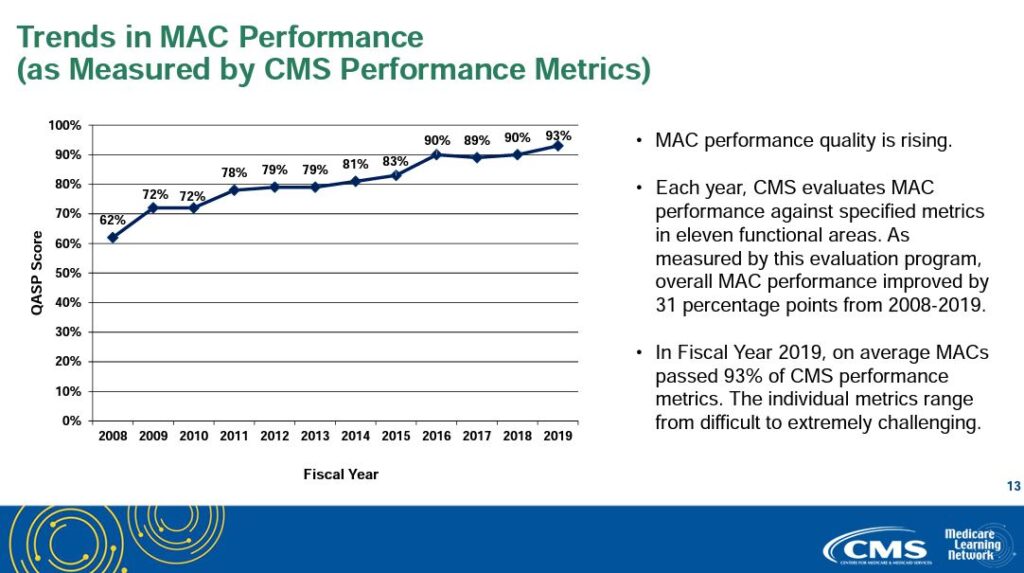
Print ‘n take hospice keys
- Seeking to contact your MAC? Here’s their contact information
hospiceKeys - CMS MAC contact
Download
- A map of MAC regional jurisdictions
hospiceKeys - CMS MAC
Download
Where can you find more information?
This PowerPoint from Medicare Learning Network provides more helpful information about MACs: MLN MAC PowerPoint

by editor | Jul 25, 2022 | Accounts Receivable, Billing, Billing - General, Financials, Metrics and KPIs
Who are Hospice Agency Payers?
A payer is the company of government agency that pays the provider, i.e., the hospice agency, for the medical service that is administered to the patient.
For most hospice agencies, Medicare is the primary payer for hospice services. See, for example, this study published by Bazell et al., 2019, https://bit.ly/3RS805r. The characteristics of payment vary by payer. As such, an agency should understand the distribution of its revenues and receivables across different payers. In addition to understanding the breakdown of total receivables, the agency should look at distribution of receivables by payer – further broken down by aging bucket.
Expected time to be paid on a claim varies by payer. For example, payment for a Medicare claim is usually received within 14 days of the date the claim is submitted. A claim submitted to a commercial payer will take longer and further varies by the commercial payer. It is important to monitor time until payment is received for each payer. Delay in payment is an opportunity to quickly identify if there is a billing error that needs to be corrected. Or, there may be an opportunity to improve the billing and collection process that will result in an increase in speed of collections.
It is also useful to compare your agency’s metrics to industry standards. Metrics that are worse than industry standards could point to areas of the collections process that could benefit from process improvement.
Aging Accounts Receivables for Medicare and Commercial Payers
The following graph shows aging accounts receivable for the Medicare payer. As we see from the graph, over 90% of the receivables are less than two months old.
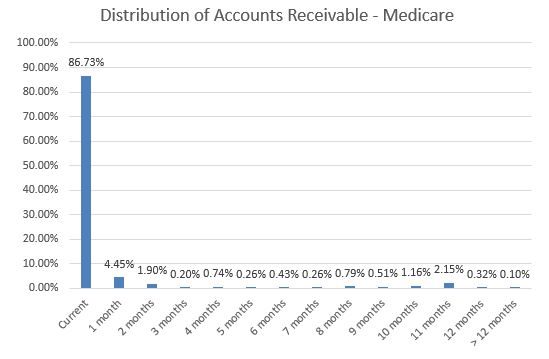
In contrast, here we can see the distribution of aging accounts receivable for commercial payers for the same hospice agency.
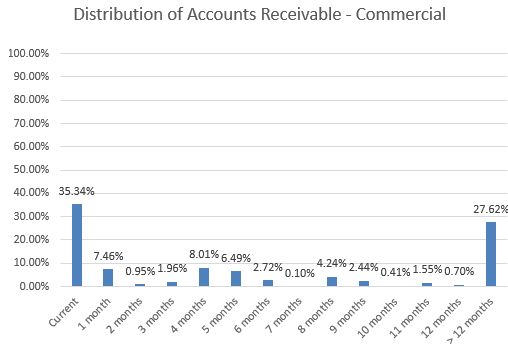
In contrast to the Medicare accounts receivables, here only 43% of the receivables are less than two months old. 25% of the receivables are between four and eight months old. More significantly, more than 25% of the outstanding receivables are more than 12 months old – a sign that there may be a high number of receivables that may have to be written off.
What is the key takeaway?
Different payers have different payment patters and different rules for timely submission of claims. Hospice agencies need to have a good understanding of the distribution of their claims and the distribution of their outstanding accounts receivable to reduce the likelihood of write-offs.

by editor | Jul 25, 2022 | Accounts Receivable, Billing, Billing - General, Financials, Metrics and KPIs
What is Aging Accounts Receivable?
The age of accounts receivable (AR) is the time that has elapsed from the time the agency delivered the service to the patient until current date. Aging AR is typically grouped into monthly buckets (e.g., 0-30 days, 31-60 days, etc.). Total dollar value of outstanding (aging) AR should be monitored each month, grouped by monthly buckets.

Consider the aging AR in the graph above. The horizontal axis shows different buckets of AR, where Medicare is the payer. “Current” represents dollars outstanding for services rendered within the most recent 30 days. “1 month” is dollars outstanding for services rendered in the most recent 31-60 days, etc. The vertical axis represents the percentage of the total Medicare dollar amounts of AR in each of the aging buckets.
How is the Accounts Receivable Distributed over Aging Buckets?
The high dollar amounts in the the first AR bucket followed by a drastic drop in outstanding AR is typical for the Medicare payer. Most agencies bill on a regular cycle (biweekly or monthly) so the large volume of outstanding AR in the “Current” bucket is mostly comprised of services that have not yet been billed out or have just been billed out to Medicare.
The outstanding AR drops but remains elevated in the “1 month” bucket. The agency is waiting to collect on services for which it has billed. It takes approximately 14 days to receive payment from Medicare. Aging AR is low in all remaining aging buckets. This is because the agency has billed and collected for most of its Medicare AR services.
What is Medicare Timely Filing?
Medicare claims must be filed no later than 12 months from the date services were provided. This includes resubmitting corrected claims that were unable to be processed. Again considering the aging AR in the graph above, note the volume of AR in the 10 month and 11 month aging buckets. AR in these aging buckets may be approaching Medicare’s timely filing deadline. Any claims in these buckets that have not yet been billed to Medicare will be not be able to be billed due to timely filing. The agency should quickly investigate the AR in these buckets.
Most agencies have a greater than 99% collection rate for Medicare AR. There should not be significant Medicare AR that is uncollectible.
In addition to monitoring total dollar value of aging AR, there are other useful classifications and breakdowns of aging AR that should be monitored on a monthly or even weekly basis.







